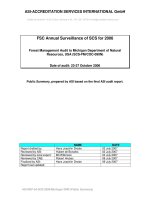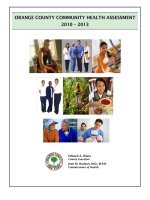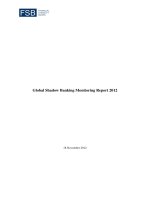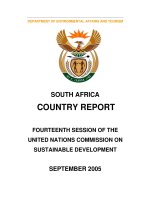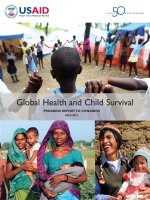GLOBAL FOREST RESOURCES ASSESSMENT 2010: COUNTRY REPORT KENYA ppt
Bạn đang xem bản rút gọn của tài liệu. Xem và tải ngay bản đầy đủ của tài liệu tại đây (183.55 KB, 47 trang )
Forestry Department
Food and Agriculture Organization of the United Nations
FRA2010/107
Rome, 2010
GLOBAL FOREST RESOURCES
ASSESSMENT 2010
C
OUNTRY REPORT
K
ENYA
2
The Forest Resources Assessment Programme
Sustainably managed forests have multiple environmental and socio-economic functions important at
the global, national and local scales, and play a vital part in sustainable development. Reliable and up-
to-date information on the state of forest resources - not only on area and area change, but also on
such variables as growing stock, wood and non-wood products, carbon, protected areas, use of
forests for recreation and other services, biological diversity and forests’ contribution to national
economies - is crucial to support decision-making for policies and programmes in forestry and
sustainable development at all levels.
FAO, at the request of its member countries, regularly monitors the world’s forests and their
management and uses through the Forest Resources Assessment Programme. This country report
forms part of the Global Forest Resources Assessment 2010 (FRA 2010).
The reporting framework for FRA 2010 is based on the thematic elements of sustainable forest
management acknowledged in intergovernmental forest-related fora and includes variables related to
the extent, condition, uses and values of forest resources, as well as the policy, legal and institutional
framework related to forests. More information on the FRA 2010 process and the results - including all
the country reports - is available on the FRA Web site (www.fao.org/forestry/fra
).
The Global Forest Resources Assessment process is coordinated by the Forestry Department at FAO
headquarters in Rome. The contact person for matters related to FRA 2010 is:
Mette Løyche Wilkie
Senior Forestry Officer
FAO Forestry Department
Viale delle Terme di Caracalla
Rome 00153, Italy
E-mail:
Readers can also use the following e-mail address:
DISCLAIMER
The designations employed and the presentation of material in this information product do not
imply the expression of any opinion whatsoever on the part of the Food and Agriculture Organization
of the United Nations concerning the legal status of any country, territory, city or area or of its
authorities, or concerning the delimitation of its frontiers or boundaries.
The Global Forest Resources Assessment Country Report Series is designed to document
and make available the information forming the basis for the FRA reports. The Country Reports have
been compiled by officially nominated country correspondents in collaboration with FAO staff. Prior to
finalisation, these reports were subject to validation by forestry authorities in the respective countries.
FRA 2010 – Country Report, Kenya
3
Contents
INTRODUCTION 5
1 TABLE T1 – EXTENT OF FOREST AND OTHER WOODED LAND 7
2 TABLE T2 – FOREST OWNERSHIP AND MANAGEMENT RIGHTS 12
3 TABLE T3 – FOREST DESIGNATION AND MANAGEMENT 16
4 TABLE T4 – FOREST CHARACTERISTICS 19
5 TABLE T5 – FOREST ESTABLISHMENT AND REFORESTATION 22
6 TABLE T6 – GROWING STOCK 24
7 TABLE T7 – BIOMASS STOCK 27
8 TABLE T8 – CARBON STOCK 29
9 TABLE T9 – FOREST FIRES 31
10 TABLE T10 – OTHER DISTURBANCES AFFECTING FOREST HEALTH AND VITALITY 34
11 TABLE T11 – WOOD REMOVALS AND VALUE OF REMOVALS 35
12 TABLE T12 – NON-WOOD FOREST PRODUCTS REMOVALS AND VALUE OF REMOVALS.37
13 TABLE T13 – EMPLOYMENT 39
14 TABLE T14 – POLICY AND LEGAL FRAMEWORK 41
15 TABLE T15 – INSTITUTIONAL FRAMEWORK 43
16 TABLE T16 – EDUCATION AND RESEARCH 45
17 TABLE T17 – PUBLIC REVENUE COLLECTION AND EXPENDITURE 47
FRA 2010 – Country Report, Kenya
4
Report preparation and contact persons
The present report was prepared by the following person(s):
Name
(FAMILY
NAME, First
name)
Institution /
address
E-mail Fax Tables
Kefa M.
Wamichwe
Kenya Forest
Service
1,2,3,4,5,67,8,9,10,11,14
Samuel Ihure
Kenya Forest
Service
Ogilo M.C.O.
Kenya Forest
Service
12,13,15&16
FRA 2010 – Country Report, Kenya
5
Introduction
Generation of reliable forest resource data in Kenya continue to be hampered by the following
challenges:
Lack of standardized and harmonized data collection and management guidelines;
Lack of a comprehensive natural resource database;
High cost of generating natural resource data;
Weak institutional linkages: Several public and private institutions possess a great deal
of data and information on natural resources that is not shared;
Inadequate capacities. Most of the institutions currently involved in natural resource data
and information management have limited capacity to collect, analyze and store accurate
scientific information on natural resources.
The Kenya report is mainly based on Kenya Forest Master plan (1994) projections owing to the
fact that no comprehensive forest resource assessment has been done since then. Other forest
resource assessments that were conducted later covered a few ecosystems and most of them do
not have published reports.
The Kenya Forest Master Plan (KFMP) conducted national forest resource assessment between
1990 and 1994, through National Forest Plantation Inventory Project, Kenya Indigenous Forest
Conservation (KIFCON) project, Department of Resource Survey and Remote Sensing
(DRSRS) and KFMP staff. The KFMP is a 25 years plan that had envisaged two scenarios. One
was on a do northing – current status scenario where the projection was done on the basis that
the current forest management at that time would continue for the next 25 years while the master
plan scenario assumed the adoption of master plan recommendations. This report quotes figures
reflecting the current scenario owing to the fact that most of the recommendations of the master
plan were not implemented. These figures also provide same trend with recent studies.
Therefore in the absence of another comprehensive forest resource assessment the Master Plan
projections have remained to be the most authoritative national forest resource estimates. Other
references in this report include data from Kenya National Bureau of Statistics (KNBS) and
management data from Kenya Forest Service.
The FAO supported AFRICOVER (2000) project data has also been considered in this report.
However due to issues of definitions, the data generated requires further synthesis to be used for
the purpose of this report and would require a consensus on some assumptions on land cover
types to be included as forest area.
In recognition of the current challenges, the government has secured funds for Natural Resource
Management (NRM) from the World Bank that has components on national forest resource
assessment. This will be done in three phases. Phase I which is ongoing is expected to be
complete by the end of this year and involves the inventory of all gazetted Forest Plantations.
The next phase will be the inventory of all indigenous forest. Phase III will be the assessment of
tree resources outside gazetted forest. The data generated will be expected to provide
information that reflects the true status of forest resources in the country.
FRA 2010 – Country Report, Kenya
6
The ministry of Forest and Wildlife launched a Forestry Mainstreaming Initiative (FMI) in April
2009. One of the tasks of this initiative will be the development of Kenya Forest Resources
Account through a multiphase account to capture the full value of forest resources. Other key
institutions include Kenya Forest Service, Kenya National Bureau of Statistics (KNBS), Kenya
Forest Research Institute (KEFRI) and Department of Resource Survey and Remote sensing
(DRSRS). It is envisaged that this process will provide the main reference data for FAO FRA
country reporting in future.
FRA 2010 – Country Report, Kenya
7
1 Table T1 – Extent of Forest and Other wooded land
1.1 FRA 2010 Categories and definitions
Category Definition
Forest Land spanning more than 0.5 hectares with trees higher than 5 meters and
a canopy cover of more than 10 percent, or trees able to reach these
thresholds in situ. It does not include land that is predominantly under
agricultural or urban land use.
Other wooded land Land not classified as “Forest”, spanning more than 0.5 hectares; with trees
higher than 5 meters and a canopy cover of 5-10 percent, or trees able to
reach these thresholds in situ; or with a combined cover of shrubs, bushes
and trees above 10 percent. It does not include land that is predominantly
under agricultural or urban land use.
Other land All land that is not classified as “Forest” or “Other wooded land”.
Other land with tree cover
(Subordinated to “Other
land”)
Land classified as “Other land”, spanning more than 0.5 hectares with a
canopy cover of more than 10 percent of trees able to reach a height of 5
meters at maturity.
Inland water bodies Inland water bodies generally include major rivers, lakes and water
reservoirs.
1.2 National data
1.2.1 Data sources
References to sources of
information
Quality
(H/M/L)
Variable(s) Year(s) Additional comments
1.Kenya Forestry Master
Plan 1994
1994 The data derived from the current
trend scenario which had envisaged
non implementation of the plan.
1.2.2 Classification and definitions
National class Definition
Indigenous forests A group of trees whose crowns are largely contiguous and include the
ecosystem that makes t up and a tree canopy cover of over 10% and the
canopy is essentially of indigenous tree species growing under natural
conditions and excludes planted indigenous plantation forests. The forest is
delineated through legal gazzetment. The area includes Mangroves and
bamboo ecosystems.
Public Plantation
Forests
All areas of systematically planted, man-managed tree resource composed of
primarily exotic species. Categories include both young and mature
plantations that have been established for commercial timber production. It
includes clear felled areas within plantations and excludes all plantations of
non-timber such as tea and coffee. It includes associated land cover/use such
as roads, fire-breaks and building infrastructure if they are too small to be
clearly mapped off the satellite imagery. The area is also legally delineated
through gazetment.
Open Woodlands Land not classified as forest with trees higher than 5 metres and canopy cover
of between 5% – 10 or trees able to reach these threshold in situ or with a
combined cover of shrubs bushes and trees above 10%. (It does not include
land that is predominantly agricultural or urban land use.
FRA 2010 – Country Report, Kenya
8
Private Forest
Plantations
As in public forest plantations privately owned.
Bush-lands Communities typically composed of tall ,woody self supporting single and
multi-stemmed plants branching at or near ground with in most cases no
clearly definable structure. Total canopy cover >10% with canopy height
between 2-5M
Grasslands All area of grassland with less than 10% tree and /or shrub canopy cover and
greater than 0.1% total vegetation cover. It is dominated by grass-like non-
woody rooted herbaceous plants.
Farmlands and
settlements
These are trees found on privately owned farmlands and settlements.
1.2.3 Original data
Area (‘000Ha) Name of variable
1990 2000 2005 (2) 2010 (3)
Indigenous closed Canopy 1 240 1 190 1 165 1140
Indigenous Mangroves 80 80 80 80
Open woodlands 2 150 2 100 2 075 2050
Public Plantation Forests (1) 170 134 119 107
Private Plantation forests (1) 68 78 83 90
Bush-land 24 800 24 635 24 570 24510
Grasslands 10 730 10 485 10 350 10350
Settlements 8 256 8 192 8 152 8202
Farms with Trees 9 420 10 020 10 320 10385
Inland water Bodies 1 123 1 123 1 123 1123
Total Area for country 58 037 58 037 58 037 58037
Notes:
1. Forest Plantation data is based on the 1991-1992 plantation survey conducted with the assistance of the
FAO Forest Inventory and Statistics Project and adjustments were made to reflect clear-felling in 1992-
1993 and increased mortality in plantations established after 1985 due to ban of the Taungya system as
a method of establishing forest plantation
s.
2. 2005 based on Kenya Forest Master Plan (1994) data projection for current trend (KFMP pp 360).
3. 2010 based on Kenya Forest Master Plan (1994) data projection for current trend (KFMP pp 360).
4. The AFRICOVER study in year 2000 data could not be used as some figures demonstrated increased
forest cover and the changes could not be explained since all other available indicators shows
decreasing trend. (See attached summary table generated from AFRICOVER data).
5. Updated data will be available after concluding the ongoing the national forest plantation inventory and
the planned Indigenous forest and trees outside gazetted forest inventory.
FRA 2010 – Country Report, Kenya
9
1.3 Analysis and processing of national data
1.3.1 Reclassification into FRA 2010 categories
Data for national classification was derived from forest inventory and tree resource assessment study undertaken
through aerial and satellite imagery while preparing the forestry sector Master plan for the country between 1992-
1994.
National Classes Forests OWL OL OLWTC
Indigenous closed
Canopy 100%
Indigenous Mangroves
100%
Open woodlands
100%
Public Plantation Forests
100%
Private Plantation forests
100%
Bush-land
100%
Grasslands
40% 60%
Settlements
100%
Farms with Trees
100%
Note: Compared to FRA 2005, the Grassland class has been reclassified differently.
1.3.2 Estimation and forecasting
Area(‘000Ha)
Name of variable
1990 2000 2005 2010
Indigenous closed Canopy 1 240 1 190 1 165 1140
Indigenous Mangroves 80 80 80 80
Open woodlands 2 150 2 100 2 075 2050
Public Plantation Forests (1) 170 134 119 107
Private Plantation forests (1) 68 78 83 90
Sub-total (Forests) 3 708 3 582 1 447 3 467
Bush-land 24 800 24 635 24 570 24 510
Grasslands (40%) 4 292 4 194 4 140 4 140
Sub-total (OWL) 29 092 28 829 28710 28 650
Grasslands (60%) 6 438 6 291 6 210 6 210
Settlements 8 256 8 192 8 152 8 202
Farms with Trees 9 420 10 020 10 320 10 385
Sub-total (OL) 24 114 24 503 24 682 24 797
FRA 2010 – Country Report, Kenya
10
1.4 Data for Table T1
Area (1000 hectares)
FRA 2010 categories
1990 2000 2005 2010
Forest
3 708 3 582 3 522
3 467
Other wooded land
29 092 28 829 28 710 28 650
Other land
24 114 24 503 24 682 24 797
of which with tree cover
9 420 10 020 10 320
10 385
Inland water bodies
1 123 1 123 1 123
1 123
TOTAL
58 037 58 037 58 037
58 037
1.5 Comments to Table T1
Variable / category Comments related to data, definitions,
etc.
Comments on the reported trend
Forest A group of trees whose crowns are
largely contiguous and a tree canopy
cover of over 10%. This includes natural
and planted plantation forests in state
and private land.
There is general trend of decline of forest
land due to degazettement of forestland to
up to 2003 and there after destruction of
trust lands forest to open areas for
agriculture especially Mau ecosystem.
Other wooded land Land not classified as forest spanning
more than 0.5 ha with trees higher than
5m and canopy cover of 5-10 percent.
Excludes land predominantly
agricultural
There is general trend of decline due to
conversion of previously pasture land to
crop land therefore clearing tree in mainly
ASAL areas.
Other land All other land not classified as forest or
woodland
There is increase of other lands mainly
affecting the expansion of towns and
agricultural lands in previous woodlands
under local authorities or group ranches
Other land with tree
cover
Other land with tree cover includes
agricultural land with tree growing
mixed with crop
The increase shows positive impact of farm
forestry and extension efforts
Inland water bodies Includes lakes and water reservoirs The has been almost constant as there is no
major dam that has been constructed during
the period
FRA 2010 – Country Report, Kenya
11
Other general comments to the table
(a) In the FRA 2000 main report (Appendix 3 On global Tables Pg 387), the total forest area from Kenya was
reported as 17 million hectares. Other schools of thought estimate forest area in the country as less than 3
million.
The reason for this discrepancy is:
1. That most of the data has been sourced from a very rapid extensive appraisal that was done during a four
year Forest Master Plan preparation between 1990-1994. During the time, and even now, most experts in the
country only consider forests as only those closed canopy and gazzetted forests with an additional area from
closed canopy private and plantation forests. The data is very old and processes for updating has started of will
be staring soon
2. Subjective nature of reclassifying the vast woodland and bush land since more or less an expert’s opinion
was used to reclassify woodland/bush land to fit the FRA definitions. Note that FRA 2000 considered
woodlands/bush land/wooded grassland as 10% closed forests, 35% open forests and the rest as OWL. FRA
however used the original definitions whereby bush land was considered to qualify as OWL (less than 5 m in
height).
(b) Sources of Data:
All data used in this report was quoted from Kenya Forest Master Plan Study done in 1994. The same source
was used widely for FRA 2000, 2005 and 2010 together with Kenya Bureau of Statistical Survey.
Expected year for completion of ongoing/planned national
forest inventory and/or RS survey / mapping
National Forest plantation inventory (ongoing) 2009
Natural forest survey using Remote sensing
commences 2009)
2010
FRA 2010 – Country Report, Kenya
12
2 Table T2 – Forest ownership and management rights
2.1 FRA 2010 Categories and definitions
Category Definition
Public ownership Forest owned by the State; or administrative units of the public
administration; or by institutions or corporations owned by the public
administration.
Private ownership Forest owned by individuals, families, communities, private co-operatives,
corporations and other business entities, private religious and educational
institutions, pension or investment funds, NGOs, nature conservation
associations and other private institutions.
Individuals
(sub-category of Private
ownership)
Forest owned by individuals and families.
Private business entities and
institutions
(sub-category of Private
ownership)
Forest owned by private corporations, co-operatives, companies and other
business entities, as well as private non-profit organizations such as NGOs,
nature conservation associations, and private religious and educational
institutions, etc.
Local communities
(sub-category of Private
ownership)
Forest owned by a group of individuals belonging to the same community
residing within or in the vicinity of a forest area. The community members
are co-owners that share exclusive rights and duties, and benefits contribute
to the community development.
Indigenous / tribal
communities
(sub-category of Private
ownership)
Forest owned by communities of indigenous or tribal people.
Other types of ownership Other kind of ownership arrangements not covered by the categories above.
Also includes areas where ownership is unclear or disputed.
Categories related to the holder of management rights of public forest resources
Public Administration
The Public Administration (or institutions or corporations owned by the
Public Administration) retains management rights and responsibilities
within the limits specified by the legislation.
Individuals/households
Forest management rights and responsibilities are transferred from the
Public Administration to individuals or households through long-term
leases or management agreements.
Private institutions
Forest management rights and responsibilities are transferred from the
Public Administration to corporations, other business entities, private co-
operatives, private non-profit institutions and associations, etc., through
long-term leases or management agreements.
Communities
Forest management rights and responsibilities are transferred from the
Public Administration to local communities (including indigenous and
tribal communities) through long-term leases or management agreements.
Other form of management
rights
Forests for which the transfer of management rights does not belong to any
of the categories mentioned above.
FRA 2010 – Country Report, Kenya
13
2.2 National data
2.2.1 Data sources
References to sources of
information
Quality
(H/M/L)
Variable(s) Year(s) Additional comments
Kenya Forest Master plan High Ownership 1994
2.2.2 Classification and definitions
National class Definition
State forest
- Any forest declared by the Minister to be a central forest, a
forest area or nature reserve as per Forests Act 2005.
Local Authority forest
- Any forest on trust land which has been set aside as forest by
a local authority pursuant to the provisions of the Trust land
Act.
- Any arboretum, recreational park or mini forest created under
section 30 of Forest Act 2005.
- Any forest established as local authority forest in accordance
with the provisions of section 24 of Forest Act 2005.
Private forest - Forest owned by individuals or corporate bodies.
2.2.3 Original data
Forest area ‘000 ha
National category 1990 2000 2005 2010 (2)
State forest 1490 1404 1364 1364
Local Authority forest 2150 2100 2075 2013
Private forest 68 78 83 90
Total 3708 3582 3522 3467
Notes:
1. Based on Kenya Forest Master Plan (1994) data projection for current trend (KFMP pp 359).
2. In 2010 the area of gazetted forests has not changed for the last 4 years and the changes are mainly on trust
lands and private forests. The areas subtracted from forest plantations are converted to indigenous forest
zones after the forest rezonation program where all plantations that were wrongly sited were rezoned to
indigenous forest areas. (expert opinion).
2.3 Analysis and processing of national data
2.3.1 Reclassification
National category FRA Categories
State forest Public ownership
Local Authority forest Local communities
Local communities of which owned by
private business entities and institutions
Private forest
Individuals, and Private business entities and institutions
FRA 2010 – Country Report, Kenya
14
2.4 Data for Table T2
Table 2a - Forest ownership
Forest area (1000 hectares)
FRA 2010 Categories
1990 2000 2005
2010
Public ownership 1 490 1 404 1 364 1 364
Private ownership 2 218 2 178 2 158 2 103
of which owned by individuals 1 2 5 10
of which owned by private business entities and institutions 67 76 78 80
of which owned by local communities 2 150 2 100 2 075 2 013
of which owned by indigenous / tribal communities 0 0 0 0
Other types of ownership 0 0 0 0
TOTAL 3 708 3 582 3 522 3 467
Note: If other types of ownership is reported, please specify details in comment to the table.
X Yes
Does ownership of trees coincide with ownership of the
land on which they are situated?
No
If No above, please describe below how the two differ:
Both are the same
Table 2b - Holder of management rights of public forests
Forest area (1000 hectares)
FRA 2010 Categories
1990 2000 2005
2010
Public Administration 1 490 1 404 1 364 1 327
Individuals 0 0 0
0
Private corporations and institutions 0 0 0
0
Communities 0 0 0
0
Other 0 0 0
0
TOTAL 1 490 1 404 1 364 1 327
FRA 2010 – Country Report, Kenya
15
2.5 Comments to Table T2
Variable /
category
Comments related to data, definitions, etc. Comments on the reported trend
Public ownership Forest owned by state and gazetted as forest reserve The decline of public forest mainly
attributed to local authority forests
lost to conversion to agriculture of
urban areas.
Private
ownership
Individual forest increasing due to
increased interest in commercial tree
farming using short rotation crops
like eucalypts for poles and fuel
wood.
Other types of
ownership
Management
rights
All public forests are managed by the government.
Other general comments to the table
The table is based on Kenya Forest Master Plan data current scenario. Decrease in public forest is likely to be
less than indicated due to enactment of the Forest Act 2005 which makes it very difficult to excise any forest
land.
Management rights include the right to utilize the resource in consultation with the Kenya Forest Service the
regulatory body. The management right are wholly with the forest owner. However the Forest Act 2005 gives
Kenya Forest Service the right to regulate the harvesting and observance of good management practices.
FRA 2010 – Country Report, Kenya
16
3 Table T3 – Forest designation and management
3.1 FRA 2010 Categories and definitions
Term Definition
Primary designated function The primary function or management objective assigned to a management unit
either by legal prescription, documented decision of the landowner/manager, or
evidence provided by documented studies of forest management practices and
customary use.
Protected areas Areas especially dedicated to the protection and maintenance of biological
diversity, and of natural and associated cultural resources, and managed through
legal or other effective means.
Categories of primary designated functions
Production Forest area designated primarily for production of wood, fibre, bio-energy
and/or non-wood forest products.
Protection of soil and water Forest area designated primarily for protection of soil and water.
Conservation of
biodiversity
Forest area designated primarily for conservation of biological diversity.
Includes but is not limited to areas designated for biodiversity conservation
within the protected areas.
Social services Forest area designated primarily for social services.
Multiple use Forest area designated primarily for more than one purpose and where none of
these alone is considered as the predominant designated function.
Other
Forest areas designated primarily for a function other than production,
protection, conservation, social services or multiple use.
No / unknown No or unknown designation.
Special designation and management categories
Area of permanent forest
estate (PFE)
Forest area that is designated to be retained as forest and may not be converted
to other land use.
Forest area within
protected areas
Forest area within formally established protected areas independently of the
purpose for which the protected areas were established.
Forest area under sustain-
able forest management
To be defined and documented by the country.
Forest area with
management plan
Forest area that has a long-term (ten years or more) documented management
plan, aiming at defined management goals, which is periodically revised.
3.2 National data
3.2.1 Data sources
References to sources of
information
Quality
(H/M/L)
Variable(s) Year(s) Additional comments
Kenya Forestry Master
Plan 1994
H 1994
FRA 2010 – Country Report, Kenya
17
3.2.2 Original data
Original data from Kenya Forestry Master Plan
Area in 1000 hectares
FRA Categories
1990 2000 2005 2010
Productive
238 212 202 197
Conservation of
biodiversity
Protection of soil and
water
3 470 3 370 3 320 3270
Total
3 708 3 582 3 522 3467
Note: This table is based on table 1 and it is assumed that all forests that are not earmarked for productive function
are mainly for protection of soil and water catchments. This is based on KFMP Table A3.2 PP391 where this
function was found to be most dominating.
Since 2005 (at least), Mt Kenya, Aberdares and Arabuko Sokoke forests have long term strategic management
plans. According to expert knowledge, forest area with management plan is 149 421 ha in 2005 and may reach 824
684 ha in 2010.
3.3 Analysis and processing of national data
3.3.1 Reclassification into FRA 2010 categories
No reclassification was necessary for forests as the national Classes and FRA definitions were compatible.
3.4 Data for Table T3
Table 3a – Primary designated function
Forest area (1000 hectares)
FRA 2010 Categories
1990 2000 2005 2010
Production 238 212 202 197
Protection of soil and water 3 470 3 370 3 320 3 270
Conservation of biodiversity 0 0 0 0
Social services 0 0 0 0
Multiple use 0 0 0 0
Other (please specify in comments below the table) 0 0 0 0
No / unknown 0 0 0 0
TOTAL 3 708 3 582 3 522 3 467
Table 3b – Special designation and management categories
Forest area (1000 hectares)
FRA 2010 Categories
1990 2000 2005 2010
Area of permanent forest estate 1 490 1 404 1 364 1 364
Forest area within protected areas n/a n/a n/a n/a
Forest area under sustainable forest management 238 212 202 197
Forest area with management plan n/a n/a 149 824
FRA 2010 – Country Report, Kenya
18
3.5 Comments to Table T3
Variable /
category
Comments related to data, definitions,
etc.
Comments on the reported trend
Production Forest area designated primarily for
production of wood, fibre, bio-energy
and/or non-wood forest products.
The decline is as a result of forest areas due
to illegal logging.
Protection of soil
and water
All natural forest are lumped together in
this category
The decline of public forest mainly attributed
to local authority forests lost to conversion to
agriculture of urban areas.
Conservation of
biodiversity
Though some forests have this function,
there are no designated forest areas for
biodiversity conservation.
Social services Though some forests have this function,
there are no designated forest areas for
Social services.
Multiple use Though some forests have this function,
there are no designated forest areas for
multiple use.
Other
No / unknown
designation
Area of permanent
forest estate
Base on table T2, all state forests are
permanent forest estate.
Forest area within
protected areas
Forest area under
sustainable forest
management
All forest plantations both state and
private are assumed to be under
sustainable forest management. (see
table T4)
Forest area with
management plan
Other general comments to the table
There are no designated natural forest functions but most of the indigenous and woodland have more than one
function and no delineation has been done at the national level for specific single functions.
The protected area from Source 1 is assumed to be under OWL.
FRA 2010 – Country Report, Kenya
19
4 Table T4 – Forest characteristics
4.1 FRA 2010 Categories and definitions
Term / category Definition
Naturally regenerated forest Forest predominantly composed of trees established through natural
regeneration.
Introduced species A species, subspecies or lower taxon, occurring outside its natural range
(past or present) and dispersal potential (i.e. outside the range it occupies
naturally or could occupy without direct or indirect introduction or care
by humans).
Characteristics categories
Primary forest Naturally regenerated forest of native species, where there are no clearly
visible indications of human activities and the ecological processes are
not significantly disturbed.
Other naturally regenerated forest Naturally regenerated forest where there are clearly visible indications of
human activities.
Other naturally regenerated forest
of introduced species
(sub-category)
Other naturally regenerated forest where the trees are predominantly of
introduced species.
Planted forest Forest predominantly composed of trees established through planting
and/or deliberate seeding.
Planted forest of introduced species
(sub-category)
Planted forest, where the planted/seeded trees are predominantly of
introduced species.
Special categories
Rubber plantations Forest area with rubber tree plantations.
Mangroves Area of forest and other wooded land with mangrove vegetation.
Bamboo Area of forest and other wooded land with predominant bamboo
vegetation.
4.2 National data
4.2.1 Data sources
References to sources of
information
Quality
(H/M/L)
Variable(s) Year(s) Additional comments
KFMP 1994 M
Forest
characteristics
1994
KNBS M
Forest
characteristics
2008
FAO The World’d
Mangroves 1980-2005.
M Mangroves
4.2.2 Classification and definitions
National class Definition
Indigenous forest
A forests which has come about by natural regeneration of trees primarily
native to Kenya, and includes mangroves and Bamboo forests forming a tree
canopy above 40%
FRA 2010 – Country Report, Kenya
20
Open woodland
A forests which has come about by natural regeneration of trees primarily
native to Kenya, Forming a tree canopy 0f between 10% – 40%
Indigenous plantation
forest
A forest that has been established using tree species that are native to Kenya
through Afforestation or reforestation for commercial purposes.
Exotic forest plantation
A forests that has been established using tree species that are not native to
Kenya through Afforestation or reforestation for commercial purposes
4.2.3 Original data
From T1 (1.3.2).
Forest area (1000 hectares)
National categories
1990 2000 2005 2010
Public Plantation Forests (1) 170 134 119 107
Private Plantation forests (1) 68 78 83 90
Total 238 212 202 197
4.3 Analysis and processing of national data
4.3.1 Reclassification into FRA 2010 categories
It is assumed that only 20% of the forest has not had human interference and can be considered as primary forest.
4.4 Data for Table T4
Table 4a
Forest area (1000 hectares)
FRA 2010 Categories
1990 2000 2005 2010
Primary forest
694 674 664 654
Other naturally regenerated forest 2 776 2 696 2 656 2 616
of which of introduced species n/a n/a n/a n/a
Planted forest 238 212 202 197
of which of introduced species 238 212 202 197
TOTAL
3 708 3 582 3 522
3 467
Table 4b
Area (1000 hectares)
FRA 2010 Categories
1990 2000 2005 2010
Rubber plantations (Forest) 0 0 0 0
Mangroves (Forest and OWL) 52 50 50 50
Bamboo (Forest and OWL) 150 150 150 150
FRA 2010 – Country Report, Kenya
21
4.5 Comments to Table T4
Variable /
category
Comments related to data, definitions,
etc.
Comments on the reported trend
Primary forest 20% of the natural forest was assumed to
be primary.
Other naturally
regenerating
forest
Planted forest The forest plantation data refers to areas
with standing trees and other designated
for forest plantation establishment and is
currently not replanted after felling the
plantation trees for commercial purposes.
Areas under indigenous forest plantations
have not been updated and therefore have
not been able to separate from exotic forest
plantations.
Rubber
plantations
There is no rubber plantation in Kenya.
Mangroves
Bamboo The area under bamboo vegetation is
approximation done by forest economic
survey report 2008.
Other general comments to the table
FRA 2010 – Country Report, Kenya
22
5 Table T5 – Forest establishment and reforestation
5.1 FRA 2010 Categories and definitions
Term Definition
Afforestation Establishment of forest through planting and/or deliberate seeding on
land that, until then, was not classified as forest.
Reforestation Re-establishment of forest through planting and/or deliberate seeding on
land classified as forest.
Natural expansion of forest Expansion of forests through natural succession on land that, until then,
was under another land use (e.g. forest succession on land previously
used for agriculture).
5.2 National data
5.2.1 Data sources
References to sources of
information
Quality
(H/M/L)
Variable(s) Year(s) Additional comments
Kenya Forest Service
Reports
M Plantations 2008 The data is extracted from Kenya
Forest Service tree planting reports
and does not include tree planting by
private tree farmers
5.2.2 Classification and definitions
National class Definition
Afforestation Establishment of forest through planting and/or deliberate seeding on land
that, until then, was not classified as forest.
Reforestation Re-establishment of forest through planting and/or deliberate seeding on land
classified as forest mainly as forest plantation or restoration of deforested
natural forest designated areas
Natural expansion of
forest
Expansion of forests through natural succession on land that, until then, was
under another land use (e.g. forest succession on land previously degraded or
deforested and currently grassland or bush land.
5.2.3 Original data
The data is extracted from Kenya Forest Service tree planting reports and does not include tree planting by private
tree farmers.
FRA 2010 – Country Report, Kenya
23
5.3 Data for Table T5
Annual forest establishment
(hectares/year)
of which of introduced species
1)
(hectares/year)
FRA 2010 Categories
1990 2000 2005 1990 2000 2005
Afforestation 0 0 0 0 0 0
Reforestation 1 588 2 490 5 675 1 268 1 931 4 661
of which on areas previously planted 1 588 2 490 5 675 1 268 1 931 4 661
Natural expansion of forest n/a n/a n/a n/a n/a n/a
5.4 Comments to Table T5
Variable /
category
Comments related to data, definitions,
etc.
Comments on the reported trend
Afforestation There is minimal tree planting in areas
that were not forest areas. More resources
are put towards reforestation
Reforestation Planting mainly done on forest plantation
designated areas that have been cleared or
enrichment planting in degraded natural
forest areas.
The data is extracted from Kenya Forest
Service tree planting reports and does not
include tree planting by private tree
farmers.
The increased trend in reforestation areas is
due to increased financial support from
government and development partners.
Natural expansion
of forest
Due to scarcity of land there is not
significant expansion of forests through
natural succession on land that, until then,
was under another land use
Other general comments to the table
FRA 2010 – Country Report, Kenya
24
6 Table T6 – Growing stock
6.1 FRA 2010 Categories and definitions
Category Definition
Growing stock Volume over bark of all living trees more than X cm in diameter at breast
height (or above buttress if these are higher). Includes the stem from ground
level or stump height up to a top diameter of Y cm, and may also include
branches to a minimum diameter of W cm.
Growing stock of commercial
species
Growing stock (see def. above) of commercial species.
6.2 National data
6.2.1 Data sources
References to sources of
information
Quality
(H/M/L)
Variable(s) Year(s) Additional comments
KFMP 1994 M GS 1994 KFMP 1994
6.2.2 Original data
From the previous tables, the following data are available:
Area (1000 hectares)
1990 2000 2005 2010
Forest 3708 3582 3522 3467
of which of natural forest 3470 3370 3320 3270
of which of forest plantation 238 212 202 197
Other wooded land 29092 28829 28710 28650
Obtained from the KFMP study of woody biomass outside forests Table A2.12
The KFMP used the above assumptions to forecast the average volume m
3
/ha. And have used the same to forecast
the 2010 woody biomass.
Average volume m3/ha
1990 2000 2005 2010
per hectare indigenous forest 176 176 175 174
Average volume per hectare for woodlands 16 16 16 16
Average volume per hectare for plantations 347 332 317 302
FRA 2010 – Country Report, Kenya
25
6.3 Analysis and processing of national data
6.3.1 Estimation and forecasting
Applying Vol/ha to the relevant vegetation class from above gives:
GS 1000 m3
1990 2000 2005 2010
Natural forest
610 720 593 120 581 000 56 980
Forest plantation
82 586 70 384 64 034 59 494
Forest
693 306 663 504 645 034 628 474
Other wooded land
465 472 461 264 459 360 458 400
6.4 Data for Table T6
Table 6a – Growing stock
Volume (million cubic meters over bark)
Forest Other wooded land
FRA 2010 category
1990 2000 2005 2010 1990 2000 2005 2010
Total growing stock 693.3 663.5 645.0 628.5
465.5 461.3 459.4 458.4
of which coniferous 82.6 70.4 64.0 59.5 n/a n/a n/a n/a
of which broadleaved 610.7 593.1 581.0 569.0 n/a n/a n/a n/a
Growing stock of
commercial species
82.6 70.4 64.0 59.5 n/a n/a n/a n/a
Table 6b – Growing stock of the 10 most common species
No data available for table T6b
FRA 2010 category / Species name
Growing stock in forest
(million cubic meters)
Rank Scientific name Common name 1990 2000 2005
1
st
2
nd
3
rd
4
th
5
th
6
th
7
th
8
th
9
th
10
th
Remaining
TOTAL
Note: Rank refers to the order of importance in terms of growing stock, i.e. 1
st
is the species with the highest
growing stock. Year 2000 is the reference year for defining the species list and the order of the species.
